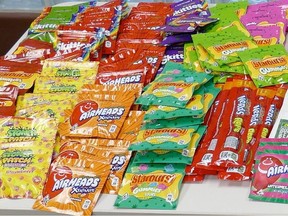While cases of childhood cannabis intoxication are still relatively rare, they are becoming more common.

Regardless of whether you favour or oppose legalization of marijuana, one hopes that we can all agree that we don’t want children to accidentally overdose on cannabis products. And yet the issue is becoming an increasingly common one.
A friend of mine in Winnipeg told me last month that as she was reviewing her kids’ Halloween candy, one of the goody bags contained a package of edible cannabis gummies. Apparently, two individuals in the area were handing them out to trick-or-treaters. When parents realized what was going on, the police were called and the individuals in question charged. The episode highlights the important and growing problem that we are sometimes a bit complacent about accidental cannabis intoxication in children.
Sign up to receive daily headline news from the Montreal Gazette, a division of Postmedia Network Inc.
Thanks for signing up!
A welcome email is on its way. If you don't see it, please check your junk folder.
The next issue of Montreal Gazette Headline News will soon be in your inbox.
In both the United States and Canada, emergency room visits and calls to poison control centres for cannabis intoxication are going up. This is not entirely surprising given the increasing availability of recreational marijuana in Canada and the U.S. states that have decriminalized its use. However, the increase in accidental overdoses in children seems to be driven largely by edibles rather than other forms of cannabis.
The problem with edibles is obvious when you consider it. Many of these products are designed and packaged to look like candy. This type of copycat packaging is not rare and is worrisome for multiple reasons. First, copycat packaging can be subtle and people may mistake these products for regular candy. Second, many of these products contain much higher levels of THC than what Health Canada mandates and what is generally considered safe. Third, colourful packaging and the resemblance to regular candy can make these products extremely attractive to children. You can’t buy these items legally in Quebec, and their packaging and dosage also run afoul of laws elsewhere; still, they find their way into homes.
Such problems were evident in the Halloween episode in Winnipeg. Because of their packaging, the edibles could have easily been mistaken for a common brand of candies and my friend had to look twice before realizing the problem. Also, the packages handed out to kids contained 600 mg of THC. This is an extremely high dose for adults, let alone children. For the record, Health Canada sets the maximum dose for edibles at 10 mg of THC. Consuming 600 mg worth of THC could have easily landed a small child in hospital. Fortunately, it appears as if no children in Winnipeg actually ate any of the edibles, but an unrelated case in Kelowna did result in a child being brought to hospital.
While cases of childhood cannabis intoxication are still relatively rare, they are becoming more common. One worries that with the enthusiasm for the decriminalization of cannabis, we sometimes overstate the medical benefits and downplay the potential risks. But the risks to children are real and even regular adult doses can lead to toxicity, let alone doses 60 times higher than the maximum adult dose.
People sometimes argue that cannabis is not any more dangerous than alcohol or cigarettes, both of which are available to the public. But we don’t let children use these products either, for obvious reasons. Alcohol overdoses in children are a significant problem as well because young children are inherently curious and prone to copying adult behaviour. But even small amounts of alcohol can pose dangers to a small child.
In the desire to make edible THC products more appealing to the general public, we face a real problem of children mistaking them for candy, especially when they are designed and packaged to resemble common snacks. As we learned with detergent pods, if you make something look like candy, kids will think it’s candy. If we’re going to sell edible cannabis gummies for recreational use, there has to be better regulation and enforcement about packing and dosing. Otherwise accidental intoxications will keep going up.
Christopher Labos is a Montreal physician and co-host of the Body of Evidence podcast.
-
Legalization of edibles linked to spike in number of children hospitalized for cannabis poisoning, study finds
-

Effects of cannabis can last hours or days longer than expected: U de M study
-

SQ pledges vigilance against illegal production and sale of cannabis


